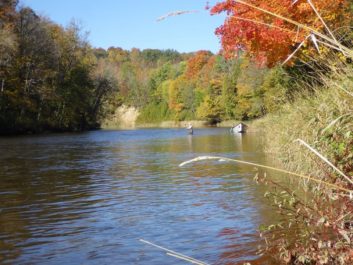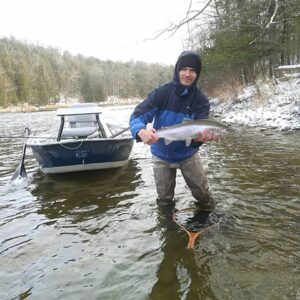There are scarce few things that we do in fly fishing that can compare to taking a fresh, fall steelhead on a swung fly. Ask anyone that has done it and they will tell you that the take from these fish can flat out mess you up for life and leave you scratching your head when it’s all over, regardless of whether or not you bring the fish to hand or it parts ways during the fight. As a transplanted Atlantic salmon enthusiast, I’ve taken my share of fish on swung flies and while I have a hard time naming a favourite, (that wouldn’t be fair to either fish) I will tell you that it is one of the coolest things that we fly folk can do. While most of our Atlantic salmon fishing is done in the top three inches of the river and tends to be very visual, most of our Great Lakes Steelhead angling takes place in increasingly deteriorating conditions, with the water and air temperatures dropping almost daily throughout the prime season, (October through to December) precipitating the need for relatively heavy flies and sinking tips. Although this takes away much of the visual aspect, it does add the element of surprise and anticipation.
Over the past 15 years, traditional presentations or those used primarily on the Pacific West Coast have taken over on many of our Great Lakes rivers, both in the U.S. and Canada. More and more two-handed rods are being utilized, with shooting heads and sink tips and it would seem that the “Down and Across” approach is fully entrenched. This is not to say that there is no need for strike indicators and deep drifting nymphs or yarn eggs, but we have learned so much about these fish over the past 15 to 20 years that refining traditional thinking and adaptation has led us to a far broader range of presentations than before.

More often than not, just being there is enough.
I hear often, from both clients and through discussions on the river, that the traditional swing is kind of a ‘cast and leave it alone’ thing but the fact is, nothing could be further from the truth if you want consistent success. To say any aspect in fly fishing, (any fishing for that matter), is easy, is enough of a misconception to make the seasoned angler cringe. I feel that it is understated that nothing that we do is particularly simple, but if you consider that maybe 20% of all the anglers out there, no matter their discipline, catch 80% of the fish, the old adage that, “If it was easy, everyone would be doing it” is particularly appropriate.
Accomplished steelhead anglers will develop a ‘touch’ if you will, that only comes through time on the water. A guide can put into the hands of his sport, the perfect combination of fly and leader but that alone does not guarantee production, as the guide cannot fish through the sports’ hands. Angles, slack line, mending, positioning, covering the water with intent and so much more comes into play that without knowing what to look for, these nuances would be lost on the casual observer. When I fish with my friends, most of whom are guides or accomplished anglers, I’m able to watch what they do after a cast and it would be difficult to argue that there most certainly is an athletic poetry to it. Like the bob and feint of a bantamweight fighter, these subtleties are designed to bring our opponent, or in our case, our quarry in and let down their guard. Most wild things are not stupid and while lacking cognitive thought, one of their primary goals is to stay alive. Every mistake that they make could be their last, so yes, they are naturally on the guard for most of their lives or hyper-vigilant to the going’s on in their environment. Everything that we do as anglers, is designed to break down that barrier, causing them to mess up.
Repetition and adaptation is the key to success in our game. Migratory fish are enigmatic and if we know one thing about them, it is that we know very little about them. Repetition only comes from frequent time on the water and putting yourself in different situations until you begin to figure out these nuances. No two runs fish exactly the same and what it takes to present a swung fly to a fish in one piece of water will most likely not be the same in the next bit. Anglers that only fish one or two beats with success could not consider themselves ‘experts’ just as a golfer that only plays one or two courses could not.

A ‘first’! Extraordinary conditions, cold feet and hands, and a thousand casts make the results that much more rewarding.
There are so many factors that it is not enough to put a sink tip on and start casting. We need to be at a specific level in the river column that is not too high to be out of reach of a holding fish and not to low as too line the fish and startle it. We also should try to achieve a specific speed so that the steelhead can at least have a fighting chance at seeing it and deciding whether or not to check it out. All of this needs to be based on water temperature, clarity, and flow and remember this, what worked last week, may not work this week.
For those that steelhead fish only occasionally, don’t expect much more than a nice day on the water because if you don’t have your ear to the ground in this endeavor, steelhead will be the mother of all unicorns. Even for the skilled and accomplished fisher, taking these fish on a swung fly, regardless of the conditions, is best described as long periods of monotony, broken up by brief periods of chaos. If you are a numbers person that bases your success on how many fish you hook in a day, you are likely better off sticking to more productive methods. However, as anglers grow, quality tends to take over from quantity and we begin to look at these fish through a different lens. Some guys may argue, “What are we here for, if not to catch fish?”, but for those of us that have evolved beyond quantity, those brief periods of chaos are what keeps us motivated.
